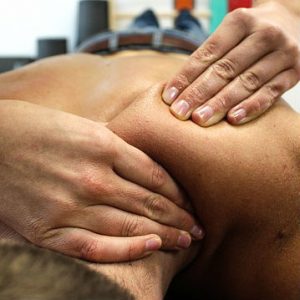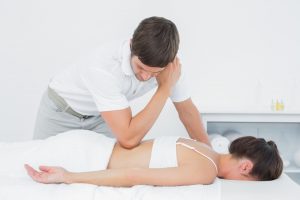There are a number of techniques that can be used during a sports massage to help aid recovery and treat injuries. Below, we discuss the different techniques and why they are used.
Myofascial Release (MFR)
 MFR is a sports massage technique that stretches the fascia in order to restore balance and function in the body. Fascia is a band or sheet sheath of connective tissue under the skin which binds the muscle fibres, maintaining the structure of organs and keeping your internal muscular system in place. Their primary functions are to connect, enclose and stabilise muscles and organs. Myofascial release eases tension and restricted fascia using applied pressure. With limited elasticity, a manipulation of the affected area through slow friction may be a sensation that you aren’t used to, but our sports massage therapist will always ensure that your comfort is our focal point.
MFR is a sports massage technique that stretches the fascia in order to restore balance and function in the body. Fascia is a band or sheet sheath of connective tissue under the skin which binds the muscle fibres, maintaining the structure of organs and keeping your internal muscular system in place. Their primary functions are to connect, enclose and stabilise muscles and organs. Myofascial release eases tension and restricted fascia using applied pressure. With limited elasticity, a manipulation of the affected area through slow friction may be a sensation that you aren’t used to, but our sports massage therapist will always ensure that your comfort is our focal point.
To a certain degree, MFR can be done yourself using tools such as a foam roller, or lacrosse/golf ball to target a specific area of deep tissue.
Soft Tissue Release (STR)
STR involves the manipulation of muscle fibres, fascia,  tendons and ligaments. This involves rapidly and repeatedly stretching small areas of soft tissue under controlled precise pressure on part of the muscle, in order to achieve a specific stretch. During the lengthening process, the stretch can either be applied passively, with the therapist moving the client’s limb, or actively, where the client moves the limb themselves to create a more forceful stretch.
STR can be used as part of a sports massage to achieve a number of things, including treating pain and reducing inflammation. Soft tissue release can precisely target small areas of muscle, making it an affective sports massage technique for chronic muscular pain, as well as other localised pain, including wrist and hand pain like carpel tunnel syndrome.
Neuromuscular Techniques (NMT)

An affective sports massage technique when treating lower back pain and other muscle pain is NMT, also known as trigger point therapy. Although one of the most tender techniques, our team can carefully use NMT to treat underlying causes of chronic pain that involve the muscular and nervous systems. It is a precise technique that addresses trigger points (hypersensitive muscle points) to release areas of tension in a muscle. These trigger points, if not attended to, can cause fatigue, weakness and pain in the muscle. NMT is often an effective method of eliminating these ‘knots’ and relieving symptoms.
Neuromuscular therapy is equally effective at treating soft tissue problems all over the body, including hip pain, upper back, neck and headaches, as well as foot pain such as plantar fasciitis.
Muscle Energy Techniques (MET)
MET is another sports massage technique used to lengthen (stretch) a muscle. It harnesses the muscle’s own energy using isometric contractions to relax a muscle. It is based around the idea that one muscle will always relax in order for the opposing muscle on the other side of the joint to contract, e.g. your hamstring contracts allowing your quadricep to relax. Reciprocal Inhibition is a type of MET that utilises the contracting muscle in order to relax the opposing/reciprocal muscle. The client will perform a muscle contraction against the resistance of the massage therapist, allowing the opposing muscle to relax and reduce aggravation of the injured soft tissue and muscle.
Post-Isometric Relaxation is a type of MET that involves the therapist providing a resisting force while the client contacts the muscle against the force. This contraction is held for up to 10 seconds before a period of relaxation, and is then repeated 3 to 5 times, with the aim to passively stretch the muscle further after each contraction. This helps to realign, relax and lengthen muscle fibres.
MET lengthen muscles, increasing mobility and range of motion. It can be used to aid a number of things, including tight hamstrings, treat chronic lower leg muscle pain, as well as upper body injuries.
Sports massage is not just for athletes and it can be beneficial to everyone. We commonly treat clients with work related issues, recovering from surgery or stress, injuries from household chores and DIY. In fact, the need for a sports massage can occur through what might be perceived as mundane daily activities.  It can aid muscle recovery, reduce post-exercise stiffness, correct soft tissue issues and prevent further injury.
For more information on the techniques we use, please get in touch and we will be happy to answer any questions you may have. Book an appointment to experience the techniques for yourself and reap the benefits today!




